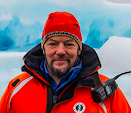
The Ice Balloon, by Alec Wilkinson
NY: Alfred A. Knopf: 2012
233 pp. $25.95
Reviewed by Lawrence Millman
Obsessed in equal measure with balloons and the North Pole, Salomon Andrée was responsible for one of the most eccentric of all assaults on the Pole. With two fellow Swedes, Nils Strindberg and Knud Fraenkel, Andrée set off from Dane Island in Svalbard in a large hydrogen-filled balloon, the Eagle. The date was July 14, 1897. Thirty-three years later, the remains of the three men (literal remains: Andrée's head and upper torso were missing) were found on White Island in northeastern Svalbard.Their journals and Strindberg's photographs, which turned out to be in somewhat better condition than the men themselves, detail an expedition that seemed doomed almost from the moment the Eagle's ballast bags were cut away.
Enter Alec Wilkinson, author of previous books about, among other subjects, moonshine and Pete Seeger. In The Ice Balloon, he takes on the Andrée balloon expedition with less than successful results. Wilkinson has never been closer to the Arctic than, it would seem, Stockholm, Sweden. This obliges him to recycle earlier accounts of Arctic expeditions, most of them in English (he admits that he doesn't know Swedish), or perpetuate the usual cliches about the unpleasantness of Arctic conditions. Unfortunately, a good many contemporary writers about the Arctic do the same thing: surf the web, read a batch of older texts, but for God's sake don't ever go to the Arctic.
Indeed, The Ice Balloon seems to consist primarily of recycled accounts of 19th century Arctic expeditions. As nearly as I can tell, the only common denominator among these expeditions is that they were all damnably uncomfortable. When Wilkinson finally gets around to describing the Andrée expedition, his laconic narrative style, derived from his tenure as a New Yorker staff writer, hardly does justice to the miseries of Andrée and his companions. Likewise, he never pursues or even contemplates certain important issues, such as what the drift of the Andrée expedition might indicate about polar currents. When Wilkinson does step out of his role as a recycler, he often ends up making mistakes. For example, Flora Island in Franz Josef Land is not "near" Svalbard, unless you consider 250 nautical miles "near."
The book devotes only a paragraph to discussing what killed Andrée and his companions. The most recent evidence suggests botulism, but Wilkinson dismisses this because he says that bacteria can't survive in very cold conditions. He's wrong, of course. They can survive in any condition -- the more extreme, the better. He dismisses another possibility, trichinosis, because the men don't refer to its symptoms in their journals. But if you're simply trying to survive from day to day, I dare say you're not going to commit every last one of your symptoms to your notebook. And with respect to trichinosis, Andrée and his men did in fact eat uncooked polar bear meat, an excellent way to get the parasitic Trichina worm in your system.
At its best, The Ice Balloon reads like Arctic Disasters 101. At its worst, it's as uninformed as any book I've read about the Arctic in quite a while. This is a pity, since there's a real need for a good book in English about the man who, upon being criticized for his recklessness by General Adolphus Greely, famously responded: "When something happened to your ships, how did you get back? I risk three lives in what you call a foolhardy attempt, and you risked how many? A shipload?"


No comments:
Post a Comment